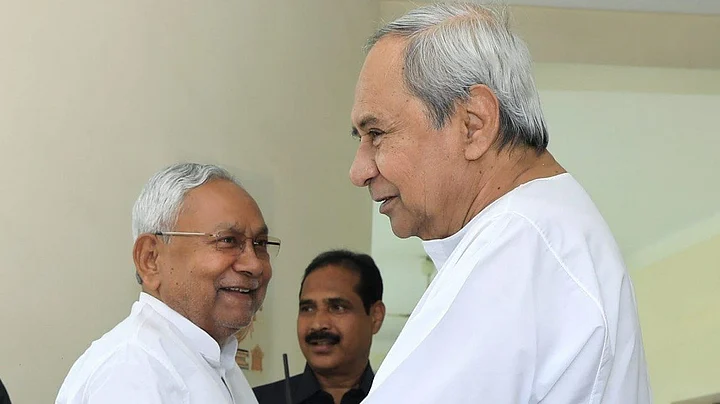Bihar Chief Minister Nitish Kumar met his Odisha counterpart Naveen Patnaik in Bhubaneswar on 9 May. Though the meeting was followed by an announcement that the Odisha government will provide land for a Bihar Bhawan in Puri, it is also been seen as part of Nitish Kumar's efforts to weave together a non-BJP coalition ahead of the 2024 Lok Sabha elections.
Of course, after the meeting, Patnaik said that 'there were no discussions on any alliances'. Besides being a five-time chief minister of Odisha, Patnaik is also the supremo of the Biju Janata Dal, a key non-BJP party.
So why is this meeting important?
What does it say about Nitish Kumar's role in the Opposition?
What are Naveen Patnaik's calculations?
Let's try and answer these questions.
Why is The Nitish Kumar-Naveen Patnaik Meeting Important?
The meeting assumes importance in the context of Nitish Kumar's attempts to broaden the anti-BJP coalition. In the past few weeks, he held meetings with Bengal CM Mamata Banerjee, Delhi CM Arvind Kejriwal, Congress president Mallikarjun Kharge and former Congress president Rahul Gandhi and Samajwadi Party chief Akhilesh Yadav.
Naveen Patnaik is the first person outside the clearly anti-BJP camp that Nitish Kumar has reached out to, which is what makes this significant.
Nitish Kumar and Naveen Patnaik are similar leaders in some ways and different in other ways.
Both Nitish Kumar and Naveen Patnaik have been chief ministers of their respective states for a very long time. Patnaik has been in power since 2000, Kumar has been CM since 2005 except for a brief interregnum in 2014.
Both leaders rule states with huge development challenges and poverty. However, they are also known to have made some efforts to address these issues, a factor that has contributed to their political success.
Both leaders are from the broader Janata Dal family and split from the parent party in the 1990s.
Nitish Kumar and Naveen Patnaik have both allied with BJP at different points of time. Significantly, both have been ministers in the Atal Bihari Vajpayee-led NDA government.
However, at present the two leaders are placed very differently. While Nitish Kumar is firmly in the anti-BJP camp, Naveen Patnaik's BJD is seen as a 'friendly' party towards the BJP, though not an ally.
Then, Nitish Kumar's party JD-U is nowhere as dominant in Bihar as the BJD is in Odisha. The JD-U has stood third in terms of vote share for the past two Assembly elections in Bihar, behind both the RJD and the BJP. The BJD, on the other hand, has a sizable 12 percentage point lead over its main challenger in Odisha.
What does it say about Nitish Kumar's role in the Opposition?
As we have written before, the non-NDA space comprises four kinds of parties - Congress allies, parties that are more anti-BJP than anti-Congress, parties that are equidistant and parties that are more anti-Congress than anti-BJP.
Patnaik is firmly in the fourth category, along with parties like YSRCP and Akali Dal. This is also a category among whom the Congress has little or no leverage.
This is where Nitish Kumar comes in.
Having spent considerable time in the NDA, Kumar is placed better than many other Opposition leaders, to reach out to this category of parties.
Nitish Kumar's importance lies in ability to at least start a conversation with parties who may otherwise not even consider being part of an anti-BJP coalition.
What are Naveen Patnaik's calculations?
However, bringing Patnaik on board is easier said than done. Presently Patnaik has no incentive to enter into an anti-BJP pre-poll alliance.
Congress has traditionally been his main rival in Odisha politics. Even though the BJP has overtaken the Congress as the main Opposition in the state, Patnaik doesn't need a pre-poll alliance with the Congress at least as of now.
In fact, some say, he would like the Opposition votes in Odisha being split between the two national parties, as has been happening for the past few elections.
However, that doesn't mean there is no space for negotiations with Patnaik.
Despite his good equation with Prime Minister Narendra Modi, Patnaik is aware that the BJP is his main challenger in Odisha now.
The BJP is desperate to increase its presence in Odisha. As the NDA may be looking at some reduction in numbers in states like Bihar, Maharashtra and Karnataka, it may be looking at Odisha as a possible state where it can gain.
Odisha is scheduled to go for polls along with the Lok Sabha elections next year, unless Patnaik decides to dissolve the Assembly earlier. So he will be up against a very strong BJP push in the state.
A weaker BJP at the Centre is in Patnaik's interest. It gives him some leverage both in Odisha and at the Centre.
But then Patnaik will have to tread a delicate path. He can a conversation going with the Opposition but he would be careful not to go too far or else there are fears he may face the heat from central agencies the way AAP and Bharatiya Rashtra Samithi are facing.
(At The Quint, we question everything. Play an active role in shaping our journalism by becoming a member today.)
